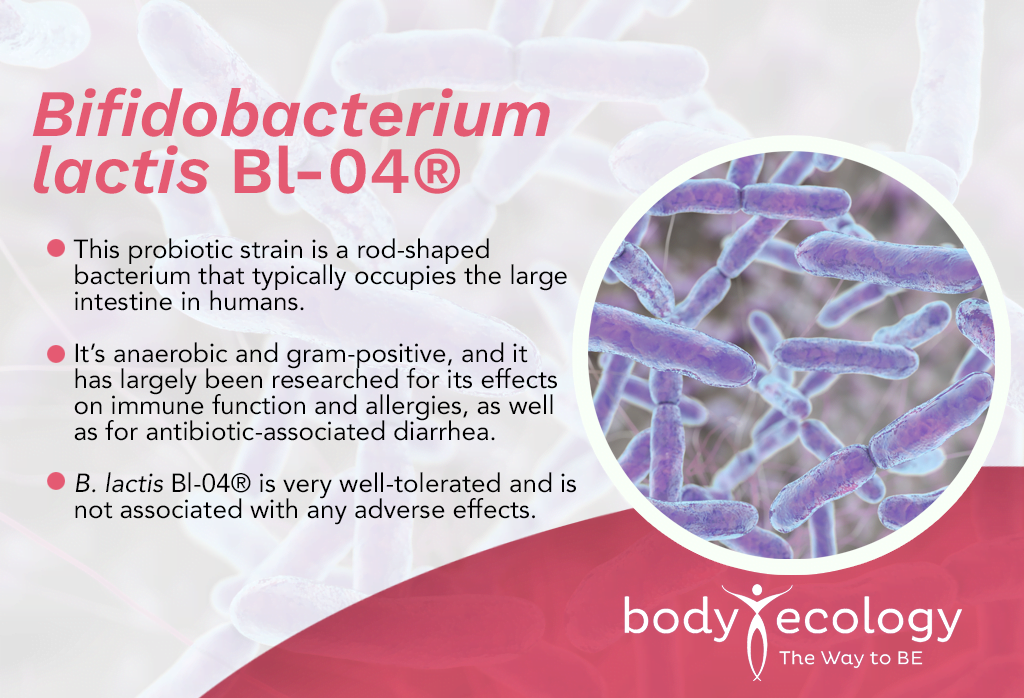
Why strains matter (if you want to get the best probiotic for your buck)
Most folks now know that probiotics are beneficial bacteria (or yeasts!) available in certain fermented foods, as well as supplements, to top up your body’s natural microbiome. But are all probiotics the same? Is there really any benefit to taking one type of bacteria over another?

In short, yes. And this is why strains matter.
When you’re born, you’re essentially a blank slate
This is in terms of the microbiome in your intestines anyway. Very quickly, however, members of the genus Bifidobacterium start to colonize the human gastrointestinal tract and exert positive health benefits on their infant host.1
Other microbes join them in short order, including beneficial members of the genus Lactobacilli and the yeast Saccharomyces boulardii. In order to survive in your body and to have any kind of valuable effects on your health, these bacteria need to have certain evolutionary adaptations.
Specifically, these bacterial species need to possess certain genes that influence:
- Which nutrients and toxins they can metabolize.
- How well they can evade destruction by their host’s immune system.
- How they interact with mucosal linings in the gut, mouth, genitourinary tract, lungs, and elsewhere where they might want to form colonies.
Because of their known health-promoting properties, Bifidobacteria are a common feature of multistrain probiotics and found in functional foods as active ingredients. Not all Bifidobacteria are the same, however, underscoring why strains matter.
What’s a bacterial strain?
- As a quick primer, bacteria are categorized by scientists with genus, species, and strain names.
- Using the example of the probiotic bacterium Lactobacillus acidophilus NCFM®, the genus is Lactobacillus, the species is acidophilus, and the strain is NCFM®.
- The strain name is often a mix of letters and numbers that help identify the research institute where the strain was discovered or tested.
In the case above, this strain of acidophilus is associated with the North Carolina Food Microbiology research center.
So, if you thought checking a label for L. acidophilus or B. bifidum was as specific as you needed to get when choosing a probiotic supplement, here’s a reality check. It’s only at the strain-specific level that you can really judge the benefits of any given probiotic.
Two studies using completely different strains of acidophilus could, for instance, have markedly different results. Meaning, lumping these two strains together without telling you what each one does doesn’t help anyone make sound choices for buying effective strains.
Unfortunately:
- While Bifidobacterium animalis subsp. lactis is the most common Bifidobacterium used in commercial dairy products in North America and Europe, the high genetic similarity of these organisms can make it hard to tell the difference between strains.
- Thankfully, more genome sequences are being run on these strains, following the publication of the first bifidobacterial genome in 2002.
The NCBI database holds hundreds of publicly available Bifidobacterium genome sequences, with full genomes available for certain bifidobacterial species. These include B. adolescentis, B. animalis, B. breve, B. bifidum, B. longum, and B. angulatum.
A full lineage (genetic sequence) was recently made available for strain HN019, and the full sequence is also available for Bifidobacterium animalis subsp. lactis Bl-04. These two strains are, quite frankly, a “better Bifidus.”
Actually, most probiotics including Bifidobacteria don’t generally form long-lasting colonies in the gut. Instead, you’ll find them primarily as transient bacteria in the stool, where they’re still very beneficial. They’re breaking down nutrients, helping them to become more bioavailable to you — like minerals — and also helping to produce vitamins — like Bs and K.
Most transient bacteria, including Bifidobacteria, are excreted two weeks or so after they’re consumed, making it essential to maintain probiotic supplementation long-term to enjoy the ongoing Bifidobacteria benefits.2
Follow us on Instagram for lots of fun freebies — like this easy coconut kefir recipe we think you’re going to love.
Looking for a better Bifidus? Exactly where to find it
The Bl-04 and HN019 strains of B. lactis have been subject to a ton of research and have demonstrated significant advantages to health compared to other strains of the same species.
So much so that researchers have noted that mapping the genome of strains in the B. animalis subsp. lactis species can help figure out how bacteria evolve and why some are more or less beneficial to human health.
In particular, researchers have looked into how different strains of this species interact with dietary carbohydrates and the lining of the intestines, as well as how well they resist bile and stomach acid and their impact on the immune system and the rest of the microbiome (including their ability to prevent inflammation in the gut).
Interestingly, some B. animalis subsp. lactis can feed on a certain kind of dietary carbohydrate called nondigestible oligosaccharides, which may be why the organism is so good at surviving longer in the large intestine when other bacteria fail.3
Here’s what the research has to say about the two “better” Bifidum strains to watch out for:
1. Bifidobacterium lactis Bl-04®.
Also known as Bifidobacterium animalis subsp lactis Bl-04®:

B. lactis Bl-04® has been seen to survive gastric acid — allowing it to get to the gut, where it works its magic.4,5 And what magic it is!
Bl-04 may help support a robust immune response to vaccines, for instance, which would make vaccines even more effective against disease. In one study, B. lactis Bl-04® was given to healthy volunteers for 21 days after they received an oral vaccine against cholera.
Compared to no changes in a group taking a placebo, volunteers receiving B. lactis Bl-04® had significant changes in immunoglobulin serum concentrations, including increased IgG in an early response to the vaccine.6
In another randomized trial, this time involving children with birch-pollen-associated hay fever, those given a combination of Lactobacillus acidophilus NCFM® and B. lactis Bl-04® had a significant reduction in a type of white blood cell involved in allergy control (eosinophils) in the nose, compared to children receiving a placebo. The kids getting probiotics also had less nasal congestion and discharge.7
Many other studies have focused on the immune support associated with Bl-04. An Australian study, for example, found that this strain was highly effective at reducing the number of colds in Australians who exercised regularly.
The double-blind, placebo-controlled study involved 465 healthy people at risk of colds because of the immune-suppressive effects of significant exercise. Again, some participants received a combination of L. acidophilus NCFM® and B. lactis Bi-07®, while others were given B. lactis Bl-04® alone. A third group received a placebo for the duration of the five-month trial.
The Bl-04 group had a 27-percent lower incidence of upper respiratory infections, which was much more pronounced than those receiving the combination probiotic or placebo.8
2. Bifidobacterium lactis HN019.
We’ve seen the many benefits of B. lactis Bl-04, but what about B. lactis HN019?

This strain has also been deemed safe in several trials. In one randomized controlled trial, a daily dose of 10 billion colony-forming units of B. lactis HN019 taken for 28 days was found to be safe and well-tolerated.9 Research suggests that this probiotic strain is also safe in pregnancy from 35 weeks’ gestation onwards and in newborns up to 2 years old.10
As for those health benefits, B. lactis HN019 has been shown to support gut motility and relieve gastrointestinal symptoms, seen in one randomized controlled trial involving 88 adults with irritable bowel syndrome (IBS). One group received 17.2 billion CFUs of B. lactis HN019, a second group took a lower dose (1.8 billion CFUs), and a third group received a placebo. Each group continued the protocol for 14 days.11
Both probiotic groups in this study had improvements in gastrointestinal symptoms, with the higher dose alleviating eight out of nine symptoms measured (compared to seven/nine symptoms with the lower dose and two/nine with the placebo). Symptoms included vomiting, regurgitation, abdominal pain, nausea, gurgling, constipation, diarrhea, irregular bowel movements, and flatulence.
The researchers also looked at the participants’ whole gut transit time and found that this improved significantly in the probiotic groups but not in the placebo group. For the higher dose group, transit time was reduced by a third (33 percent), with a 25-percent reduction in the lower dose group.
Another study looked at the benefits of B. lactis HN019 in 228 adults with constipation — again with a high-dose group taking 10 billion CFUs and a low-dose group taking 1 billion CFUs, plus a placebo group.
After 28 days, those participants with the worst constipation had more bowel movements per week when taking the probiotics. The higher dose group also reported less straining, with the study overall supporting the use of B. lactis HN019 to improve bowel regularity.4
B. lactis HN019 isn’t just helpful for constipation, though:
- This strain can also have benefits for the overall health of the gut microbiome.
- One study using a milk drink containing 30 billion CFU of B. lactis HN019 daily for four weeks found that participants had significant increases in levels of Lactobacilli and Bifidobacteria.
- There were no changes in gut microbiota in the placebo group.12
In addition, B. lactis HN019 supports immune system health, with one study finding that supplementing with the strain for three weeks led to notable improvements in phagocytosis (the immune system’s way of engulfing and killing pathogens that cause infection). Interestingly, even the short-term use of this probiotic strain had a sustained effect on healthy immune function for another two weeks or so after stopping supplementation.2
Similar benefits for immune function were also seen in older adults taking B. lactis HN019 for three weeks. The greatest benefits were seen in those with poor immune response at the start of the study.13 A meta-analysis also concluded that B. lactis HN019 supports natural immune system function in older adults, including enhancing phagocytosis and the activity of Natural Killer cells.14
And just as B. lactis HN019 supports older adults:
- It may also support the very youngest among us, helping with the development of the immune system even before a baby is born.
- In one study, pregnant women took B. lactis HN019 daily for two to five weeks prior to delivery and continued to six months postpartum.
- Levels of various markers for robust immune system function were higher in breastmilk in the group taking the probiotic and in cord blood, compared to women taking a placebo.15
B. lactis HN019 was also associated with improved iron status and reduced risk of anemia in children aged 1 to 4 years in another trial using a daily milk drink fortified with 19 billion CFUs of the probiotic strain, plus a prebiotic providing 2.4 grams of oligosaccharides, for a year. Children taking the probiotic/prebiotic combo were an impressive 45-percent less likely to develop anemia, compared to the group taking a placebo.16
There’s one final documented benefit of B. lactis HN019 worth looking at before we wrap things up: the metabolic effects of this probiotic strain as seen in a randomized controlled trial involving 51 adults with metabolic syndrome. Participants received either no intervention or 80 mL of fermented milk, providing 27.2 billion CFUs of B. lactis HN019, for 45 days.17
The probiotic group had a significant reduction in body mass index and levels of total cholesterol and the harmful low-density lipoprotein cholesterol (LDL-C).
The researchers also noted a reduction in levels of pro-inflammatory cytokines in the group taking B. lactis HN019, suggesting significant benefits of the probiotic strain for cardiovascular health and other concerns with metabolic syndrome.
What it all means: While B. lactis Bl-04 and HN019 are far from the only beneficial Bifidobacteria, they are two of the strains with the most research to support claims that they can benefit human health. This is why these two strains were hand-picked for our brand-new GI Distress Relief™ formula, alongside Saccharomyces boulardii (a beneficial species of yeast) and Sunfiber® (a prebiotic that helps enhance the growth of Bifidus).
With bacteria, strains matter. GI Distress Relief™ provides 40 billion CFUs of these two well-researched strains, plus 10 billion CFUs of S. boulardii, per serving to help relieve gastrointestinal symptoms while supporting all-around health.
REFERENCES:
- 1. O’Callaghan A, van Sinderen D. (2016). Bifidobacteria and Their Role as Members of the Human Gut Microbiota. Front Microbiol, 7:925.
- 2. Chiang BL, Sheih YH, Wang LH, et al. (2000). Enhancing immunity by dietary consumption of a probiotic lactic acid bacterium (Bifidobacterium lactis HN019): optimization and definition of cellular immune responses. Eur J Clin Nutr, Nov;54(11):849-55.
- 3. Barrangou R, Briczinski EP, Traeger LL, et al. (2009). Comparison of the complete genome sequences of Bifidobacterium animalis subsp. lactis DSM 10140 and Bl-04. J. Bacteriol. 191, 4144–4151.
- 4. Cox, AJ. et al (2014) Effects of probiotic supplementation over 5 months on routine haematology and clinical chemistry measures in healthy active adults. Eur J Clin Nutr.68 (11):1255-7.
- 5. Forssten, S. D., & A. C. Ouwehand, A. C., (2017) ‘Simulating colonic survival of probiotics in single-strain products compared to multi-strain products’. Microbial Ecology in Health and Disease, 28(1): 1378061, DOI: 10.1080/16512235.2017.1378061.
- 6. Paineau, D. et al, (2008), ‘Effects of seven potential probiotic strains on specific immune responses in healthy adults: a double-blind, randomised, controlled trial’. FEMS Immunology and Medical Microbiology, 53 (1):107-13.
- 7. Ouwehand et al, (2014) ‘Probiotics reduce symptoms of antibiotic use in a hospital setting: A randomized dose response study’. Vaccine, 32(4):458-63.
- 8. West NP et al., (2014), ‘Probiotic supplementation for respiratory and gastrointestinal illness symptoms in healthy, physically active individuals’, Clinical Nutrition, 33(4):581-7.
- 9. Ibarra A, Latreille-Barbier M, Donazzolo Y, et al. (2018). Effects of 28-day Bifidobacterium animalis subsp. lactis HN019 supplementation on colonic transit time and gastrointestinal symptoms in adults with functional constipation: A double-blind, randomized, placebo-controlled, and dose-ranging trial. Gut Microbes, 9(3):236-251.
- 10. Decker JW, Wickens K, Black PN, et al. (2009). Safety aspects of probiotic bacterial strains Lactobacillus rhamnosus HN001 and Bifidobacterium animalis ssp. lactis HN019 in human infants aged 0 to 2 years. Int Dairy J, 19:149–154.
- 11. Waller PA, Gopal PK, Leyer GJ, et al. (2011). Dose-response effect of Bifidobacterium lactis HN019 on whole gut transit time and functional gastrointestinal symptoms in adults. Scand J Gastroenterol, 46(9):1057-1064.
- 12. Gopal P et al. (2003). Effects of the consumption of Bifidobacterium lactis HN019 (DR10TM) and galacto-oligosaccharides on the microflora of the gastrointestinal tract in human subjects’. Nutr Res, 23: 1313-1328.
- 13. Gill H et al. (2001). Enhancement of immunity in the elderly by dietary supplementation with the probiotic Bifidobacterium lactis HN019. Am J Clin Nutr, 74: 833-839.
- 14. Miller L et al. (2017). The Effect of Bifidobacterium animalis ssp. lactis HN019 on Cellular Immune Function in Healthy Elderly Subjects: Systematic Review and Meta-Analysis. Nutrients, 9(3):191.
- 15. Prescott SL et al. (2008). Supplementation with Lactobacillus rhamnosus or Bifidobacterium lactis probiotics in pregnancy increases cord blood IFNy and breast milk transforming growth factor B and immunoglobin A detection. Clinical and experimental Allergy , 38 (10): 1606- 1614.
- 16. Sazawal S et al. (2010). Effects of Bifidobacterium Lactis HN019 and Prebiotic Oligosaccharide Added to Milk on Iron Status, Anemia, and Growth Among Children 1 to 4 Years Old. J Pediatr Gastroenterol Nutr, 51(3):341-6.
- 17. Bernini L et al. (2016). Beneficial effects of Bifidobacterium lactis on lipid profile and cytokines in patients with metabolic syndrome: A randomised trial. Effects of probiotics on metabolic syndrome. Nutrition, 32(6):716-9.









